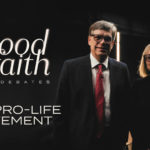Bird Box begins in hell.
Hell, in this case, is a rapidly escalating global catastrophe—a creaturely presence that, upon being seen, drives one to sudden and violent death by suicide. The only way to save oneself is not to see this evil. Survival depends on remaining behind darkened windows when inside and wearing a blindfold when out.
Adapted from a 2014 novel, the Netflix original film (directed by Danish filmmaker Susanne Bier) was viewed a record-breaking 45 million times within a week of its release. As thrillers go, Bird Box is intense. (It kept the adrenaline of this suspense addict jacked up for all 124 minutes.) The suicide scenes are so disturbing that some have (understandably) called for trigger warnings for the sake of viewers struggling with mental illness or suicidal thoughts.
The suspenseful content is heightened by the story’s artful structure, which effectively cuts back and forth between scenes taking place just before, during, and several years after the onset of the apocalypse. This non-chronological order does more than just build suspense, however. It also highlights the development of the central character, Malorie (Sandra Bullock), from reluctant to loving mother.
Horror of Parenting
This parenting theme is one reason many compare Bird Box to last year’s A Quiet Place, leaving some to wonder if the former merely imitated the latter (which isn’t the case, since the novel Bird Box was published in 2014, with the film rights sold in 2013 before the book was even released).
Even so, the similarities between the films are notable. Viewers unversed in the genre may not realize how central a role parenting—whether good or ill—plays in horror films from Carrie to Halloween to The Shining. Both A Quiet Place and Bird Box portray parents and parenting in a positive light—an unexpected, but welcome tilt of a common trope.
The horror in these two films is also directly connected to the senses—hearing in A Quiet Place and sight in Bird Box. In this age of sensory overload (manifested, increasingly and not surprisingly, in sensory disorders), these films demonstrate how the horror genre always deals in some way with whatever scares us most in any given age.
A Quiet Place and Bird Box demonstrate how the horror genre always deals in some way with whatever scares us most in any given age.
What scares Malorie is becoming a parent. The film hints that her fears about becoming a mother are directly connected to her own parents’ problems. In a conversation with her sister (Sarah Paulson) about a horse her sister hopes to purchase, Malorie says wryly, “Great to be a horse. Then we would have, like, a mother who would have actually raised us and a father off on some faraway stud farm.”
“Hold on,” her sister responds. “Our father was off on a faraway stud farm.”
The film opens several years after this conversation, with Malorie sharply commanding a young boy and girl, both blindfolded as they set off on a dangerous boat ride down a river. Then a flashback (the first of many) returns to a heavily pregnant (and single) Malorie, who is so detached from the child she carries that her obstetrician gently suggests she consider placing the baby up for adoption. Not only does Malorie keep the child (birthed in terrifying circumstances, also similar to A Quiet Place), but she also takes into her care another child whose mother falls victim to the apocalyptic plague. Adoption thus emerges as one of the film’s more subtle but interesting themes, a theme reinforced by the birds of the titular box.
Birds and Blindness
The birds serve a number of functions in the story, both literal and symbolic. One thematic purpose is explicit in the film’s script but doesn’t appear to show up in the film. The movie portrays Malorie obtaining the birds in an abandoned grocery store. The script states that “a trampled sign on the floor” reads, “TODAY ONLY / ADOPT A PET!” Malorie does.
The investment of so much care in such seemingly insignificant creatures as small birds, under the circumstances, is a stretch of the imagination—unless viewed within the context of the film’s central theme about risking love in a dangerous world. It’s a world in which loving someone—a child, a sibling, a spouse, even a pet—all but guarantees the pain of loss.
The thematic significance of the film’s central image of blindness/seeing goes back at least as far as the ancient Greek dramatist Sophocles, and much chatter by viewers (not to mention the viral memes) about Bird Box centers on interpretations of just what kind of moral, personal, or social “blindness” the film suggests.
Echoes of Genesis
However, it’s the more subtle archetypal symbols that increase the film’s interest for me (spoilers below). The safety Malorie seeks for herself and the children is found in a boat, a type of ark. At a critical moment, Malorie faces a kind of Sophie’s Choice between one life or another—and refuses to choose. Immediately afterward, the boat capsizes, and the trio’s journey on the boat ends. She and the children are immersed the river’s waters in a kind of baptism before undertaking the last steps in their pilgrimage. Like Christian’s journey in Pilgrim’s Progress, they must resist the pull of voices that would lure them away from their destination. They must resist the temptation to take off the blindfold, opting instead to (literally) “walk by faith, not by sight” (2 Cor. 5:7).
In a reverse Genesis narrative, Bird Box ends with an entrance into, rather than an expulsion from, a kind of Eden. Unlike Adam and Eve, who were ejected from Eden for their insistence on knowing, Malorie enters not by knowing, but by trusting. This is a paradise not incorruptible like the new heaven and the new earth, but one that is lush, flourishing, full of love, and a shelter from the unseen evil terrorizing the outside world. It is a place where birds beckon and warn by song, fly free, and play upon a canopy of trees, recalling a story told earlier in the film to the children, a story of hope Malorie refused to hear because she was afraid to hope. She so lacked in hope, in fact, that she refused to name the children. Reminiscent of Cormac McCarthy’s unnamed “boy” protagonist in his apocalyptic novel The Road, the children in Bird Box are simply called “boy” and “girl.”
In a reverse Genesis narrative, Bird Box ends with an entrance into, rather than an expulsion from, a kind of Eden.
But when Malorie arrives at an Edenic garden hidden away, she finds hope. Startlingly, delightfully, the refuge is populated by those who have what in the pre-apocalyptic world would be considered a disability but is, ironically, lifesaving. In their weakness is their strength. All along—until that pivotal point earlier in the boat—Malorie has believed her power lie in her invulnerability to both external evil and internal emotion. At last, she gives up her resistance to risky love and, like Adam in that first Eden, gives the children names, declaring to the others—but mostly herself—“I am their mother.”
Is there enough evidence for us to believe the Gospels?
 In an age of faith deconstruction and skepticism about the Bible’s authority, it’s common to hear claims that the Gospels are unreliable propaganda. And if the Gospels are shown to be historically unreliable, the whole foundation of Christianity begins to crumble.
In an age of faith deconstruction and skepticism about the Bible’s authority, it’s common to hear claims that the Gospels are unreliable propaganda. And if the Gospels are shown to be historically unreliable, the whole foundation of Christianity begins to crumble.



































